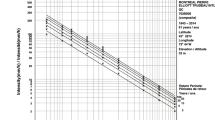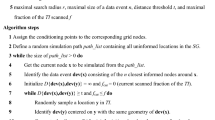Abstract
Three problem-dependent meanings for engineering “extremes” are motivated, established, and translated into formal geostatistical (model-based) criteria for designing infill sample networks. (1) Locate an area within the domain of interest where a specified threshold is exceeded, if such areas exist. (2) Locate the maximum value in the domain of interest. (3) Minimize the chance of areas where values are significantly different from predicted values. An example application on a simulated dataset demonstrates how such purposive design criteria might affect practice.
Similar content being viewed by others
References
Armstrong, M., and Matheron, G., 1986a, Disjunctive kriging revisited: part I: Math. Geology, v. 18. no. 8. p. 711–728.
Armstrong, M., and Matheron, G., 1986b, Disjunctive kriging revisited: part II: Math. Geology, v. 18, no. 8, p. 729–742.
Aspie, D., and Barnes, R. J., 1990, Infill-sampling design and the cost of classification errors: Math. Geology, v. 22. no. 8, p. 915–932.
Attanasi, E. D., and Karlinger, M. R., 1979. Worth of data and natural disaster insurance: Water Resources Research, v. 15, no. 6, p. 1763–1766.
Barnes, R. J., 1989. Sample design for geologic site characterization,in Armstrong, M., ed., Geostatistics, Vol. 2: Kluwer, Dordrecht, p. 809–822.
Barnes, R. J., and Watson, A. G., 1992, Efficient updating of kriging estimates and variances: Math. Geology, v. 24. no. 1. p. 129–134.
Bras, R. L.. and Colon, R., 1978, Time-averaged areal mean of precipitation: estimation and network design: Water Resources Research, v. 14, no. 5, p. 878–888.
Bras, R. L., and Rodríguez-Iturbe, I., 1976a. Network design for the estimation of areal mean of rainfall events: Water Resources Research, v. 12, no. 6, p. 1185–1195.
Bras, R. L., and Rodríguez-Iturbe, I., 1976b, Rainfall network design for runoff prediction: Water Resources Research, v. 12. no. 6, p. 1197–1208.
Burgess, T. M., Webster, R., and McBratney, A. B., 1981. Optimal interpolation and isarithmic mapping of soil properties: IV. Sampling Strategy: Jour. Soil Science, v. 32, no. 4.
Cressie, N. A. C., 1991. Statistics for spatial data: John Wiley & Sons. New York, 900 p.
Davis, D. R., Duckstein, L., and Krysztofowicz, R.. 1979. The worth of hydrologie data for nonoptimal decision making: Water Resources Research, v. 15, no. 6, p. 1733–1742.
Davis, D. R., and Dvoranchik, W. M., 1971, Evaluation of the worth of additional data: Water Resources Bull., v. 7. no. 4, p. 700–707.
Dawdy, D. R., 1979, The worth of hydrologic data: Water Resources Research, v. 15, no. 6, p. 1726–1732.
Deutsch, C. V., and Journel, A. G., 1992, GSLIB: Geostatistical Software Library and user's guide: Oxford Univ. Press, New York. 340 p.
Duckstein, L., and Kisiel, C. C., 1971. Efficiency of hydrologic data collection systems: role of Type I and Type II Errors: Water Resources Bull., v. 7, no. 3. p. 592–604.
Gershon, M., 1983, Optimal drillhole location using geostatistics: Soc. Mining Engineers preprint 83-63, Littleton, Colorado, unpaginated.
Journel, A. G., 1983, Nonparametric estimation of spatial distributions: Math. Geology, v. 15, no. 3, p. 445–468.
Journel, A. G., and Alabert, F., 1988, Non-gaussian data expansion in the earth sciences: Terra Review, v. 1, no. 2, p. 123–134.
Journel, A. G., and Huijbregts, C., 1978, Mining geostatistics: Academic Press. London, 600 p.
Manoukian, E. B., 1986, Modem concepts and theorems of mathematical statistics: Springer-Verlag, New York, 156 p.
Naylor, T. H., Baintfy, J. L., Burdick, D. S., and Chu, K., 1966, Computer simulation techniques: John Wiley & Sons, New York, 352 p.
Rodríguez-Iturbe, I., and Mejia, J. M., 1974, The design of rainfall networks in time and space: Water Resources Research, v. 10, no. 4, p. 1185–1195.
Rouhani, S., 1985, Variance reduction analysis: Water Resources Research, v. 21, no. 6, p. 837–846.
Thompson, S. K., 1992, Sampling: John Wiley & Sons, Inc., New York, 343 p.
Veneziano, D., and Kitanidis, P. K., 1982, Sequential sampling to contour an uncertain function: Math. Geology, v. 14, no. 5, p. 387–404.
Verly, G., 1983. The multigaussian approach and it applications to the estimation of local reserves: Math. Geology, v. 15, no. 3. p. 263–290.
Author information
Authors and Affiliations
Rights and permissions
About this article
Cite this article
Watson, A.G., Barnes, R.J. Infill sampling criteria to locate extremes. Math Geol 27, 589–608 (1995). https://doi.org/10.1007/BF02093902
Received:
Revised:
Issue Date:
DOI: https://doi.org/10.1007/BF02093902




